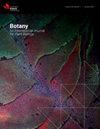长寿树种的空间遗传模式:墨西哥中部被人类改变的地貌中的 Pinus leiophylla 案例
IF 1.3
4区 生物学
Q3 PLANT SCIENCES
引用次数: 0
摘要
植物学》,提前印刷。 对于寿命较长的物种,砍伐森林会改变近期种群的遗传多样性模式。研究人员在墨西哥中部残存种群的成株和幼苗中调查了 Pinus leiophylla Schiede ex Schltdl.对来自三个地方的两组(成株和幼苗)121 个叶绿体基因间区域进行了测序。发现成虫的遗传分化(ФST = 0.09)高于幼苗(ФST = 0.03)。主成分的判别分析发现了四个遗传集群,Mantel 检验发现了微弱但显著的距离隔离模式(r2 = 0.05,p = 0.002)。根据遗传邻域分析,16% 的遗传变异由空间成分解释。利用 ResistanceGA 对三种景观特征,即海拔、地势(正弦和余弦)和土地利用的影响进行了探讨,发现土地利用显著限制了种群间的基因流动,主要是在农耕类别中。这项研究强调了保护森林植被对维持 P. leiophylla 残存种群之间的连通性所起的关键作用。这项研究的启示将有助于保护墨西哥温带森林中的针叶树,尤其是在人类活动严重改变的地貌中。本文章由计算机程序翻译,如有差异,请以英文原文为准。
Spatial genetic patterns of a long-lived tree species: the case of Pinus leiophylla in a human-altered landscape of central Mexico
Botany, Ahead of Print.
In long-lived species, deforestation can modify the genetic diversity patterns of recent populations. The spatial-structure genetics of Pinus leiophylla Schiede ex Schltdl. & Cham. was investigated in adults and seedlings of remnant populations from central Mexico. Two chloroplast intergenic regions were sequenced of two cohorts (adults and seedlings) of 121 individuals of P. leiophylla from three localities. Higher genetic differentiation was found in adults (ФST = 0.09) than in seedlings (ФST = 0.03). The discriminant analysis of principal components detected four genetic clusters and the Mantel test found a weak but significant isolation by distance pattern (r2 = 0.05, p = 0.002). Sixteen percent of genetic variation was explained by the spatial component according to the genetic neighborhood analysis. And the effect of three landscape features, i.e., elevation, aspect (sine and cosine), and land use, explored with ResistanceGA, detected that land use significantly restricts gene flow between populations, mostly in the farming category. This study emphasizes the critical role of preserving forest cover to maintain connectivity among remnants of P. leiophylla. Insights of this study will contribute to the conservation of conifers in Mexican temperate forests, especially within landscapes heavily altered by human activities.
In long-lived species, deforestation can modify the genetic diversity patterns of recent populations. The spatial-structure genetics of Pinus leiophylla Schiede ex Schltdl. & Cham. was investigated in adults and seedlings of remnant populations from central Mexico. Two chloroplast intergenic regions were sequenced of two cohorts (adults and seedlings) of 121 individuals of P. leiophylla from three localities. Higher genetic differentiation was found in adults (ФST = 0.09) than in seedlings (ФST = 0.03). The discriminant analysis of principal components detected four genetic clusters and the Mantel test found a weak but significant isolation by distance pattern (r2 = 0.05, p = 0.002). Sixteen percent of genetic variation was explained by the spatial component according to the genetic neighborhood analysis. And the effect of three landscape features, i.e., elevation, aspect (sine and cosine), and land use, explored with ResistanceGA, detected that land use significantly restricts gene flow between populations, mostly in the farming category. This study emphasizes the critical role of preserving forest cover to maintain connectivity among remnants of P. leiophylla. Insights of this study will contribute to the conservation of conifers in Mexican temperate forests, especially within landscapes heavily altered by human activities.
求助全文
通过发布文献求助,成功后即可免费获取论文全文。
去求助
来源期刊

Botany
生物-植物科学
CiteScore
2.20
自引率
9.10%
发文量
48
期刊介绍:
Botany features comprehensive research articles and notes in all segments of plant sciences, including cell and molecular biology, ecology, mycology and plant-microbe interactions, phycology, physiology and biochemistry, structure and development, genetics, systematics, and phytogeography. It also publishes methods, commentary, and review articles on topics of current interest, contributed by internationally recognized scientists.
 求助内容:
求助内容: 应助结果提醒方式:
应助结果提醒方式:


